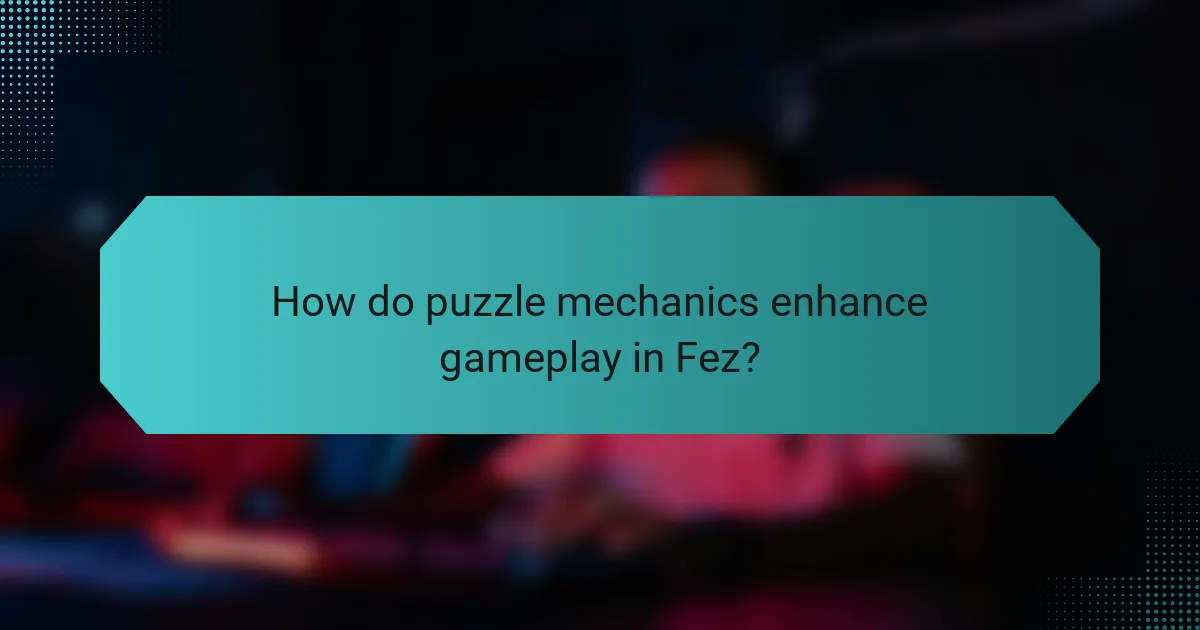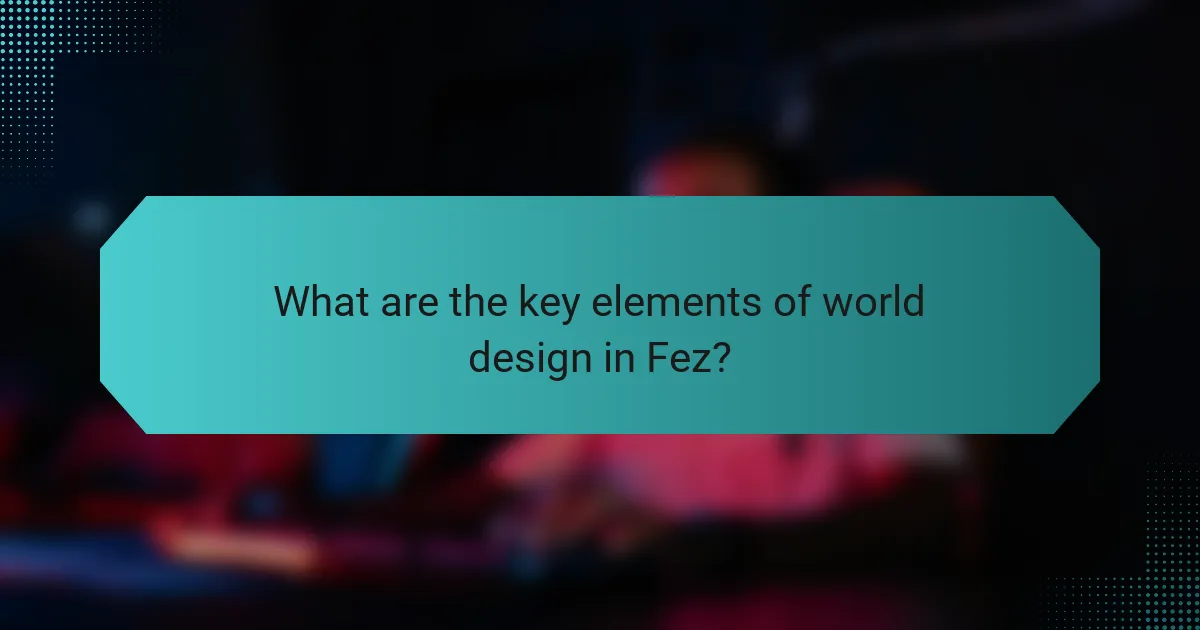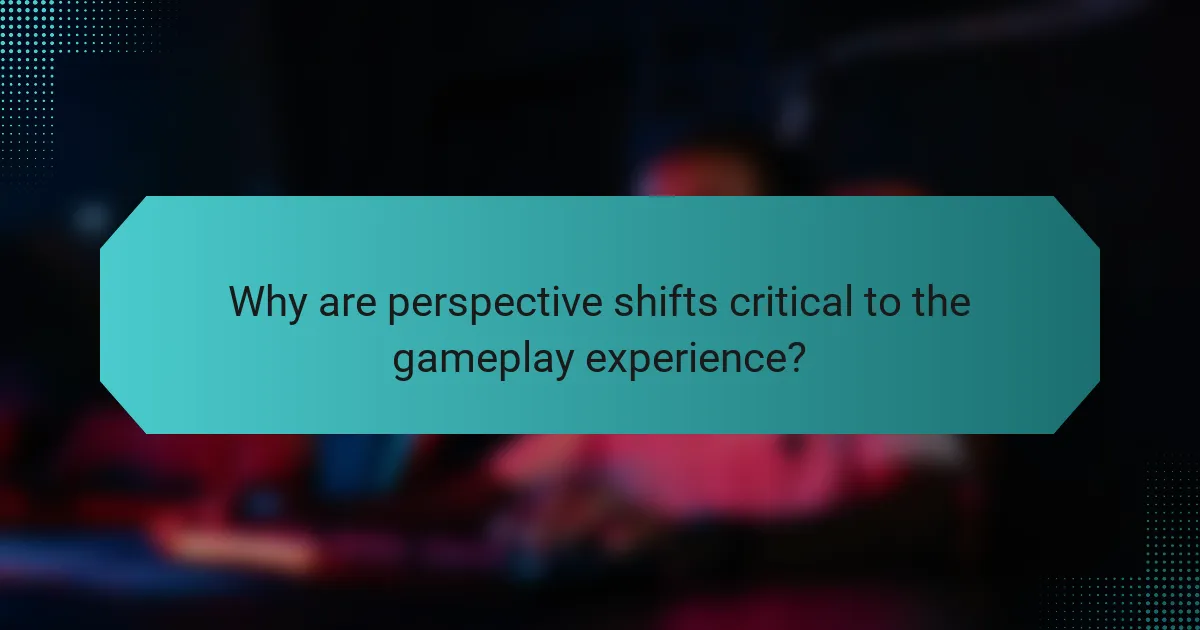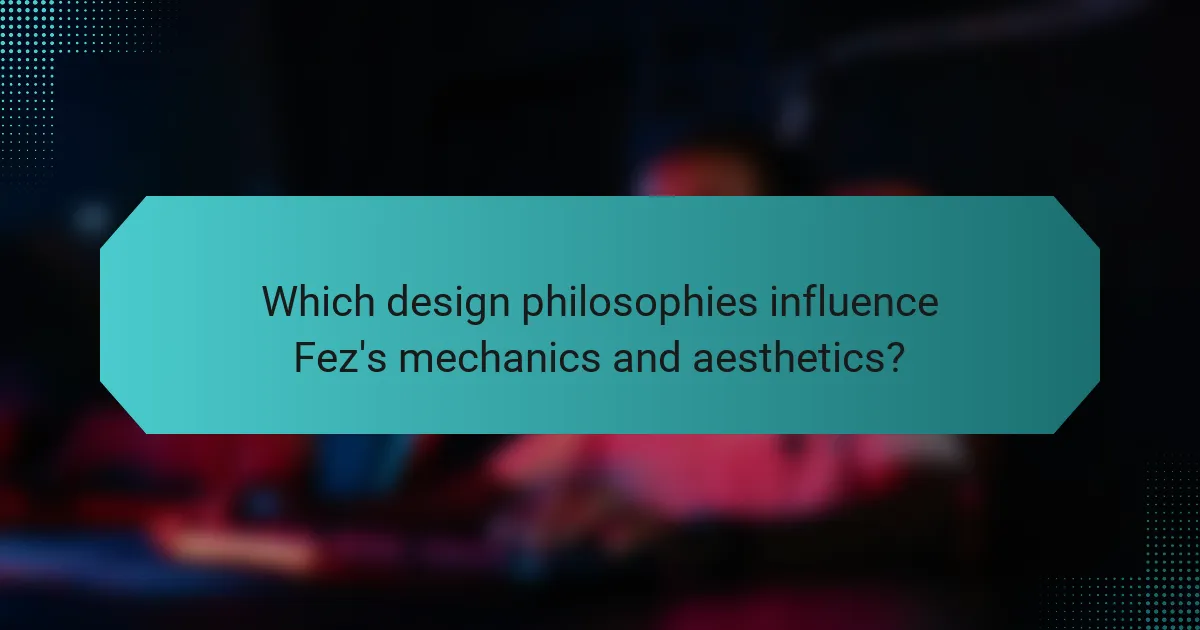Fez captivates players with its intricate puzzle mechanics and innovative world design. The game challenges players through perspective shifts and spatial puzzles. It encourages exploration and critical thinking while fostering engagement with its vibrant environment. Fez’s unique integration of 2D and 3D elements enhances the overall gameplay experience.

How do puzzle mechanics enhance gameplay in Fez?
Puzzle mechanics in Fez significantly enhance gameplay by introducing complex, multi-layered challenges. These mechanics encourage exploration and critical thinking, requiring players to manipulate the game’s unique 2D/3D perspective shifts. Each puzzle often integrates environmental elements, reinforcing the connection between world design and problem-solving.
The game’s design promotes a sense of discovery, as players must unlock secrets hidden within the vibrant world. This interactivity fosters engagement, ensuring players remain invested in the narrative. Additionally, the puzzles vary in difficulty, appealing to a broad range of skill levels, which keeps the gameplay fresh and stimulating.
By intertwining puzzles with the narrative, Fez creates a cohesive experience where solving challenges feels rewarding and integral to the story. This synergy between puzzle mechanics and world design ultimately elevates the overall gameplay experience.
What types of puzzles are featured in Fez?
Fez features various types of puzzles, including spatial, logic, and language-based challenges. These puzzles encourage exploration and utilize perspective shifts, enhancing the gameplay experience. Spatial puzzles involve manipulating the 2D and 3D environments, while logic puzzles often require players to deduce solutions based on clues. Language-based puzzles engage players through cryptic messages and symbols, adding depth to the narrative. Each puzzle type contributes to the game’s unique design and immersive world.
How does the game utilize perspective shifts in puzzles?
Fez employs perspective shifts to create complex puzzles that require players to think in three dimensions. By rotating the 2D world, players reveal hidden pathways and manipulate the environment. This mechanic enhances spatial reasoning and encourages exploration, as new perspectives can alter the layout of the game. Each shift reveals unique attributes of the world, transforming familiar areas into new challenges. The innovative use of perspective not only deepens gameplay but also reinforces the overarching theme of perception in Fez.
What role does exploration play in puzzle-solving?
Exploration is crucial in puzzle-solving as it uncovers hidden elements and mechanics within the game. In “Fez,” players navigate a richly designed world that requires shifting perspectives to solve intricate puzzles. This exploration encourages players to interact with the environment, revealing unique attributes and solutions that enhance gameplay. The game’s design emphasizes curiosity and discovery, making exploration a fundamental aspect of the puzzle-solving experience.

What are the key elements of world design in Fez?
The key elements of world design in Fez include perspective shifts, spatial puzzles, and a unique 2D/3D integration. Perspective shifts allow players to manipulate the environment, revealing hidden paths and solutions. Spatial puzzles challenge players’ understanding of space and dimensions, encouraging exploration. The integration of 2D and 3D elements creates a distinct gameplay experience, enhancing immersion and engagement.
How does the 2D-to-3D perspective shift affect world navigation?
The 2D-to-3D perspective shift enhances world navigation by allowing players to explore hidden paths and solve puzzles. This mechanic transforms spatial awareness, enabling players to view environments from multiple angles. In Fez, the ability to rotate the world reveals previously inaccessible areas, promoting exploration and critical thinking. Players must adapt to this dynamic perspective, making navigation both challenging and rewarding. The unique attribute of perspective shifting in Fez fundamentally alters how players interact with the game world, emphasizing discovery and creativity.
What unique world-building techniques are employed in Fez?
Fez employs unique world-building techniques through its 2D/3D perspective shifts and spatial puzzles. The game allows players to rotate the world, transforming 2D surfaces into 3D spaces. This mechanic creates an innovative exploration experience, challenging perceptions of depth and dimension. Additionally, the use of visual storytelling and environmental cues enhances immersion, encouraging players to engage with the world creatively. These techniques set Fez apart in the puzzle-platformer genre, emphasizing discovery and interaction.
How does the environment contribute to puzzle mechanics?
The environment significantly enhances puzzle mechanics in Fez by providing spatial and visual cues. These elements encourage players to explore and interact with the world, revealing hidden pathways and solutions. The unique perspective shifts allow players to perceive the environment differently, transforming how puzzles are approached. This interplay between environment and mechanics fosters a deeper engagement, making the gameplay experience richer and more immersive.

Why are perspective shifts critical to the gameplay experience?
Perspective shifts are critical to the gameplay experience in Fez as they unlock new dimensions and solutions. These shifts allow players to view the world from multiple angles, revealing hidden pathways and puzzles. The unique attribute of Fez’s design is its 2D-to-3D transition, which enhances spatial awareness. As a result, players engage in deeper problem-solving and exploration, making each discovery rewarding. This mechanic not only enriches gameplay but also fosters a sense of wonder and curiosity.
How do perspective shifts alter player perception of space?
Perspective shifts in Fez significantly enhance player perception of space by altering dimensionality and navigation. Players experience a unique interaction with the environment, as rotating the 2D world reveals hidden paths and puzzles. This mechanic fosters a deeper understanding of spatial relationships, challenging traditional gameplay norms. As a result, players engage more fully with the game’s design, experiencing a sense of discovery that transforms their approach to problem-solving.
What challenges do perspective shifts present to players?
Perspective shifts in Fez challenge players by altering spatial perception and puzzle-solving strategies. These shifts require players to rethink their approach to navigation and interaction within the game world. Players must adapt to new perspectives to uncover hidden areas and solve complex puzzles. This dynamic can lead to moments of confusion but ultimately enhances the gameplay experience by fostering creativity and critical thinking.
How do perspective shifts tie into the narrative of Fez?
Perspective shifts are central to Fez’s narrative, enhancing gameplay and storytelling. These shifts allow players to view the 2D world in a 3D context, revealing hidden paths and secrets. This mechanic deepens player engagement, encouraging exploration and problem-solving. The unique attribute of perspective manipulation creates a dynamic experience, making each puzzle feel fresh and innovative. As a result, the narrative unfolds in layers, inviting players to piece together the story through their discoveries.

Which design philosophies influence Fez’s mechanics and aesthetics?
Fez’s mechanics and aesthetics are influenced by various design philosophies, including minimalism, exploration, and perspective shifts. Minimalism emphasizes simplicity in design and gameplay, allowing players to focus on puzzles without distractions. Exploration encourages discovery within a vibrant, interconnected world, rewarding curiosity. Perspective shifts introduce a unique gameplay mechanic, altering the player’s viewpoint to reveal new paths and solutions. These philosophies collectively create a cohesive experience that enhances player engagement and immersion.
What inspirations shaped the visual style of Fez?
The visual style of Fez was shaped by influences from 8-bit and 16-bit art, creating a nostalgic yet modern aesthetic. The game incorporates a unique perspective shift mechanic, allowing players to experience the world in new dimensions. This design is inspired by classic platformers and puzzle games, emphasizing exploration and discovery. The vibrant color palette and geometric design enhance the overall visual appeal, making it distinct in the indie game landscape.
How does Fez balance challenge and accessibility in its design?
Fez balances challenge and accessibility through intuitive puzzle mechanics and clever world design. The game employs perspective shifts that allow players to view the environment from multiple angles, enhancing spatial awareness. This design choice makes complex puzzles approachable while maintaining engagement. Additionally, the gradual introduction of mechanics ensures players build skills without overwhelming frustration, catering to a broad audience. The unique attribute of its non-linear progression allows for personalized experiences, enabling players to tackle challenges at their own pace.
What feedback mechanisms are present in Fez to guide players?
Fez employs various feedback mechanisms to guide players, including visual cues, sound effects, and environmental design. These elements provide immediate responses to player actions, enhancing puzzle-solving experiences. For example, changing colors indicate interaction possibilities, while ambient sounds signal nearby secrets. Additionally, the world design encourages exploration, rewarding players with visual and auditory feedback upon discovering hidden areas or completing challenges. This multifaceted approach ensures players remain engaged and informed throughout their journey.

What community and cultural impacts has Fez had since its release?
Fez has significantly influenced community engagement and cultural conversations in gaming. Its unique puzzle mechanics and world design fostered collaboration among players.
The game’s emphasis on perspective shifts encourages players to view challenges from multiple angles. This has led to discussions about creativity in game design and problem-solving strategies.
Fez has also inspired local art and indie game development, creating a ripple effect in cultural expressions. Events and meetups often celebrate its impact, showcasing community-driven projects.
Additionally, Fez’s success has highlighted the value of indie games in the broader gaming industry, encouraging support for independent developers and diverse storytelling.
How has Fez influenced indie game development?
Fez has significantly influenced indie game development through its innovative puzzle mechanics, intricate world design, and unique perspective shifts. The game showcases how to blend art and gameplay, encouraging developers to explore non-linear storytelling and visual creativity.
The use of perspective shifts in Fez creates a dynamic gameplay experience, prompting players to think outside traditional 2D constraints. This approach has inspired many indie developers to experiment with spatial puzzles and visual storytelling techniques.
Additionally, Fez’s emphasis on exploration and discovery has led to a greater appreciation for atmospheric game design in the indie scene. Developers are now more inclined to create immersive worlds that invite players to engage deeply with the environment.
Overall, Fez serves as a benchmark for indie games, demonstrating the potential of innovative mechanics and artistic vision in shaping player experiences.
What are the most common player strategies for solving puzzles?
Players commonly use exploration, pattern recognition, and perspective shifts as strategies for solving puzzles in Fez. Exploration encourages players to thoroughly investigate the world, uncovering secrets and items essential for progression. Pattern recognition helps players identify relationships between symbols, colors, and shapes, facilitating puzzle solutions. Perspective shifts enable players to rotate the 2D world into a 3D space, revealing hidden pathways and clues. These strategies enhance the gameplay experience, promoting critical thinking and creativity.
What lessons can be learned from Fez’s approach to game design?
Fez’s approach to game design teaches the importance of innovative puzzle mechanics, immersive world design, and effective perspective shifts. These elements create a unique gameplay experience that challenges players’ perceptions and problem-solving skills. The use of perspective shifts allows players to view the game world in different dimensions, enhancing exploration and discovery. Additionally, the carefully crafted puzzles encourage critical thinking, rewarding players for their creativity and persistence. Overall, Fez exemplifies how thoughtful design can elevate player engagement and satisfaction.
What best practices can enhance player engagement in puzzle games?
To enhance player engagement in puzzle games like Fez, focus on innovative mechanics and immersive world design. Incorporate perspective shifts that challenge players’ spatial reasoning and encourage exploration.
Utilize the following best practices:
1. **Dynamic Mechanics**: Introduce evolving puzzle mechanics that adapt to player skills, ensuring a balance between challenge and accessibility.
2. **Layered World Design**: Create multi-dimensional environments that reward exploration, revealing hidden areas and secrets that deepen the gameplay experience.
3. **Visual Feedback**: Provide clear visual cues and feedback for puzzle interactions, helping players understand their impact and encouraging experimentation.
4. **Narrative Integration**: Weave puzzles into the narrative, making them integral to the story progression and enhancing emotional investment.
5. **Community Involvement**: Foster a community around the game where players can share strategies and solutions, increasing engagement through social interaction.